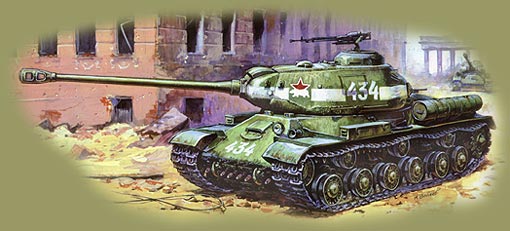| Heavy Tanks of the "JS" Series |
|---|

| Heavy Tanks of the "JS" Series |
|---|

The weight of both tanks was the same. The JS-2 had better penetration ability, it could penetrate the Panther's frontal armor from 1100-1200 metres, while the Panther could penetrate the JS-2's armor from only 600-700 metres. In addition, the 122 mm gun had greater HE ability which is extremely important for combat with anti-tank guns and infantry (the weight of a 122 mm fragmentation shell was 25 kg, while the German - only 4.7 kg). One of the main drawbacks of the JS-2 was a small magazine - only 28 shells (the Panther had 81 rounds). The JS-2 had multi-part loading shots which slowed reloading and, as a result, resulted in a low rate of fire. Today, most tank enthusiasts are interested in the AP ability of tank guns, forgetting the HE ability. However, that is ridiculous and stupid! The JS-2 was a heavy breakthrough tank, i.e. a tank intended for breaking through the enemy's lines of defense. In other words, the main targets of this tank were infantry and artillery. Thus, a tank with a large gun with great HE capability was needed. History showed that the JS-2 used about 70% of its HE ammunition and only 30% of its AP ammunition. That's why the HE ability was considered more important. Also, the JS-2 had much better armor protection than the Panther, but heavy armoring constrained by low weight dictated less internal space for the JS-2's crew and ammunition (this was the main reason for the small ammo magazine). Moreover, the Panther had better specific power - 15 hp/ton, while the JS-2 - only 11.3 hp/ton, which was also very important. |
Compared with the Tiger, the JS-2 was slightly better protected even though it was ten tons lighter.. The 88 mm and 122 mm guns had more or less the same AP ability, but again, German gun had less HE ability. Both tanks could penetrate each other's frontal armor from ~1000 metres. At greater distances success highly depended on experience of the crew and battle conditions. The JS-2 had thicker armor, thus it had a better chance at distances over 1500 metres. On the other hand, the Tiger had better optics and thus had a better chance of hitting the JS-2. The main drawback of the Tiger was the slow angular velocity of the turret. However, the Tiger had an excellent length/width ratio (almost 1:1) which made it extremely maneuverable. And if the Tiger could not traverse its turret fast enough, the whole tank could swivel to bring the gun to bear. |
In August 1944, new German tanks appeared on the Eastern Front: King (Koenig) Tigers. Weighing 68 tons, this tank was larger and much heavier than the JS-2. The first engagement of Soviet tanks with King Tigers did not favor the Germans; on August 13 of 1944 a company of JS-2 tanks (the 3rd Battalion of the 71st Guards Heavy Tank Regiment) commanded 1st Lieutenant Klimenkov engaged in close combat with German tanks, knocked out one King Tiger and burnt another King Tiger. About at the same time, a single JS-2 of the 1st Lieutenant Udalov ambushed 7 King Tigers, knocked out one of them and burnt another one. Survived five German tanks attempted to retreat but Udalov made a maneuver and destroyed third King Tiger. Four other tanks flee in panic. Details of that battle are here. Anyway, engagements between JS-2's and King Tigers were rare because the Germans seldom used them on the Eastern Front. On 12 November 1944, not far from Budapest, a skirmish occurred between JS-2's and King Tigers of the 503rd PzAbt. Both sides lost several tanks. On January 12, 1945, a column of King Tigers of the 524th PzAbt engaged in close combat with JS-2's (near Lisuv). In the fierce battle both sides had heavy losses. It is not fair to compare the JS-2 and King Tiger because of the large disparity in weight - more than 20 tons! It would be better to classify the King Tiger as a super-heavy tank. It had thicker armor and its 88 KwK gun was slightly superior in AP ability, though inferior in HE ability. Many times I noticed some individuals tried to compare armor penetration values of the 8,8-cm KwK 43 and the 122-mm D-25T. Unfortunately, these individuals paid no attention on different nature of those values: they were calculated by different methods. In short, the difference of calculation was about 25%. Therefore, it would be better to either increase Soviet figures on 25% or decrease German figures. Of course, the result would be very approximate, but it is much better then direct comparison. The reliability of the King Tiger was poor, especially of first series, this is clearly stated in the follow report. The rate of fire of the King Tiger was definitely higher, ammo load was also larger. From the other side, the mobility of the JS-2 was much better. Further, the JS-2 was much cheaper than the King Tiger, which is also a very important consideration. |
Sources:
"Report of the artillery tests of the armor protection of JS-85 and JS-122" NII-48, Sverdlovsk, 1944 "A short technical report about the improving the armoring of the JS" NII-48, Sverdlovsk, 1944 "Studying the JS tanks being destroyed in summer-autumn 1944" NII-48, Sverdlovsk, 1945 "From the experiense of usage a tanks during the Great Patriotic War. Part one" 1946 "Heavy tanks and SP guns in action" NKTP, 1945 "About the tactic of the heavy tanksand SP guns during the street fighting" handbook, 1945 |